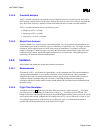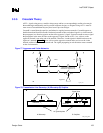
Intel
®
820E Chipset
R
Design Guide 147
The transmission line package models must be inserted between the output of the buffer and the net it is
driving. Likewise, the package model must also be placed between a net and the input of a receiver
model. This is performed, generally, by editing the simulator’s net description or topology file.
Intel has found wide variation in noise margins when varying the stub impedance and the PCB’s Z0 and
S0. Intel therefore recommends that PCB parameters be controlled as tightly as possible, with sampling
of the allowable Z0 and S0 simulated. The Intel PGA370-socketed Pentium
III processor’s nominal
effective line impedance (Z
EFF
) is 60 Ω ± 15%. Intel recommends a baseboard nominal effective line
impedance of 60
Ω ± 15% for the recommended layout guidelines to be effective. Intel also recommends
both running uncoupled simulations using the Z
0
of the package stubs as well as performing fully coupled
simulations if increased accuracy is needed or desired. Accounting for crosstalk within the device
package by varying the stub impedance was investigated and was not found to be sufficiently accurate.
This led to the development of full-package models for the component packages.
3.2.4. Place and Route Board
3.2.4.1. Estimate Component-to-Component Spacing for AGTL+ Signals
Estimate the number of layers that will be required. Then determine the expected interconnect distances
between each component on the AGTL+ bus. Using the estimated interconnect distances, verify that the
placement can support the system timing requirements.
The required bus frequency and the maximum flight time propagation delay on the PCB determine the
maximum network length between the bus agents. The minimum network length is independent of the
required bus frequency.
Table 52 and Table 53 assume values for CLKSKEW and CLKJITTER parameters that are controlled by
the system designer. To minimize the system clock skew, Intel recommends clock buffers that allow their
outputs to be tied together. Intel strongly recommends running analog simulations to ensure that each
design has adequate noise and timing margins.
3.2.4.2. Layout and Route Board
Route the board satisfying the estimated space and timing requirements. Also stay within the solution
space set from the pre-layout sweeps. Estimate the printed circuit board parameters from the placement
and other information, including the following general guidelines:
• Distribute V
TT
with a power plane or a partial power plane. If this cannot be accomplished, use as
wide a trace as possible and route the V
TT
trace with the same topology as the AGTL+ traces.
• Keep the overall length of the bus as short as possible, but do not forget the minimum component-
to-component distances required to meet hold times.
• Plan to minimize crosstalk with the following guidelines developed for the example topology given.
(Signal spacing recommendations were based on fully coupled simulations. Spacing may be
decreased based upon the amount of coupled length.)
Use a spacing-to-line width-to-dielectric thickness ratio of at least 3:1:2. If ε
r
= 4.5, this should
limit coupling to 3.4%.
Minimize the dielectric process variation used in PCB fabrication.
Eliminate parallel traces between layers not separated by a power or ground plane.
Table 54contains the trace width:space ratios assumed for this topology. The crosstalk cases considered
in this guideline involve three types: intragroup AGTL+, intergroup AGTL+, and AGTL+ to non-


















